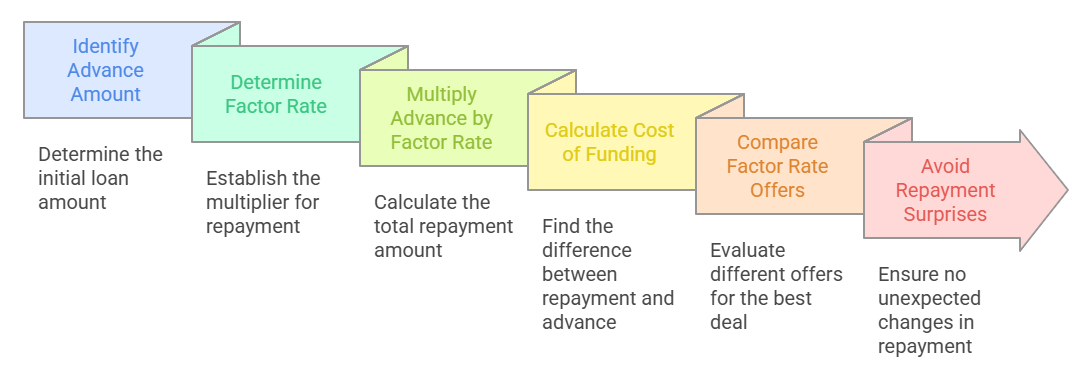What Is a Factor Rate in Business Funding
When exploring alternative financing options, business owners often encounter the term 'factor rate' and wonder what is a factor rate in business funding. This multiplier plays a crucial role in determining your total repayment amount and understanding the true cost of financing. Unlike traditional interest rates, factor rates provide a straightforward way to calculate exactly how much you'll repay over the life of your funding arrangement.
Factor rates typically appear in merchant cash advances and short-term business financing products. They're expressed as decimal numbers, usually ranging from 1.1 to 1.5, which means you might repay between 1.1 and 1.5 times the original advance amount. This transparency helps business owners make more informed decisions about their financing options.
Understanding Factor Rate Basics
Understanding factor rate basics begins with recognizing that this isn't an interest rate but rather a multiplier that determines your total repayment obligation. When you receive business funding with a factor rate, you're agreeing to pay back a fixed amount regardless of how quickly you repay the advance.
- Factor rates are expressed as decimal numbers, typically between 1.1 and 1.5
- They represent a multiplier of the original advance amount
- The total repayment amount remains fixed throughout the funding period
- Factor rates provide transparency in cost calculation from the beginning
This straightforward approach to pricing helps merchants understand their financial obligations upfront. Unlike traditional financing where interest accrues over time, factor rates offer predictability in repayment planning.
How Factor Rate Calculation Works
How factor rate calculation works involves a simple multiplication process that determines your total repayment amount. The calculation provides immediate clarity on what you'll owe, making it easier to evaluate whether the funding fits your business budget.

- Multiply the advance amount by the factor rate to get total repayment
- A $10,000 advance with a 1.3 factor rate equals $13,000 total repayment
- The difference between advance and repayment represents the cost of funding
- This calculation method eliminates confusion about compounding interest
- Business owners can quickly compare different factor rate offers
This transparent calculation method helps merchants avoid surprises in their repayment obligations. The fixed nature of factor rate pricing means your total cost won't change based on market conditions or payment timing.
Factor Rate vs Traditional Interest
Factor rate vs traditional interest represents two different approaches to pricing business funding. While both determine the cost of financing, they work in fundamentally different ways that affect your repayment strategy and financial planning.
- Factor rates create fixed repayment amounts regardless of payment speed
- Traditional interest rates accrue over time and reward early repayment
- Factor rates offer predictable cost calculation from day one
- Interest rates may fluctuate based on market conditions or creditworthiness
Understanding these differences helps you choose the right type of financing for your business situation. Factor rates might work better for businesses that prefer predictable repayment amounts, while traditional interest rates could benefit those planning to repay quickly.
Steps to Calculate Your Total Cost
Steps to calculate your total cost using factor rates follow a straightforward process that any business owner can master. This calculation empowers you to make informed funding decisions and plan your cash flow effectively.

- Identify the advance amount you're considering for your business needs
- Note the factor rate offered by the funding provider
- Multiply the advance amount by the factor rate for total repayment
- Subtract the advance amount from total repayment to find the cost
- Compare this cost against other funding options available to you
This systematic approach to cost calculation ensures you understand exactly what you're agreeing to before accepting funding. Many business owners find this transparency helpful when budgeting for repayments and evaluating multiple financing offers.
Planning Your Repayment Strategy
Planning your repayment strategy with factor rate funding requires understanding how payments typically work and how they affect your daily cash flow. Most factor rate funding involves daily or weekly payments that align with your business revenue patterns.
- Review your daily or weekly revenue patterns to ensure payment feasibility
- Calculate the percentage of daily sales that will go toward repayment
- Consider seasonal fluctuations in your business when planning payments
- Build a buffer into your cash flow projections for unexpected expenses
Effective repayment planning helps ensure that your funding arrangement supports rather than strains your business operations. The fixed nature of factor rate repayments can actually make budgeting easier once you understand the payment structure.
Understanding what is a factor rate in business funding empowers you to make confident financing decisions for your business. This transparent pricing method offers predictable costs and straightforward calculation, making it easier to plan your repayment strategy and manage cash flow effectively.
Factor rates provide an alternative to traditional interest-based financing that might better suit businesses looking for predictable repayment amounts. By mastering the calculation process and understanding how factor rates work, you can evaluate whether this type of financing aligns with your business goals and financial situation.
When considering factor rate funding, remember to calculate the total cost, compare it with other options, and ensure the repayment structure fits your business's revenue patterns. This knowledge helps you choose funding solutions that support your business growth while maintaining healthy cash flow.

.png)






